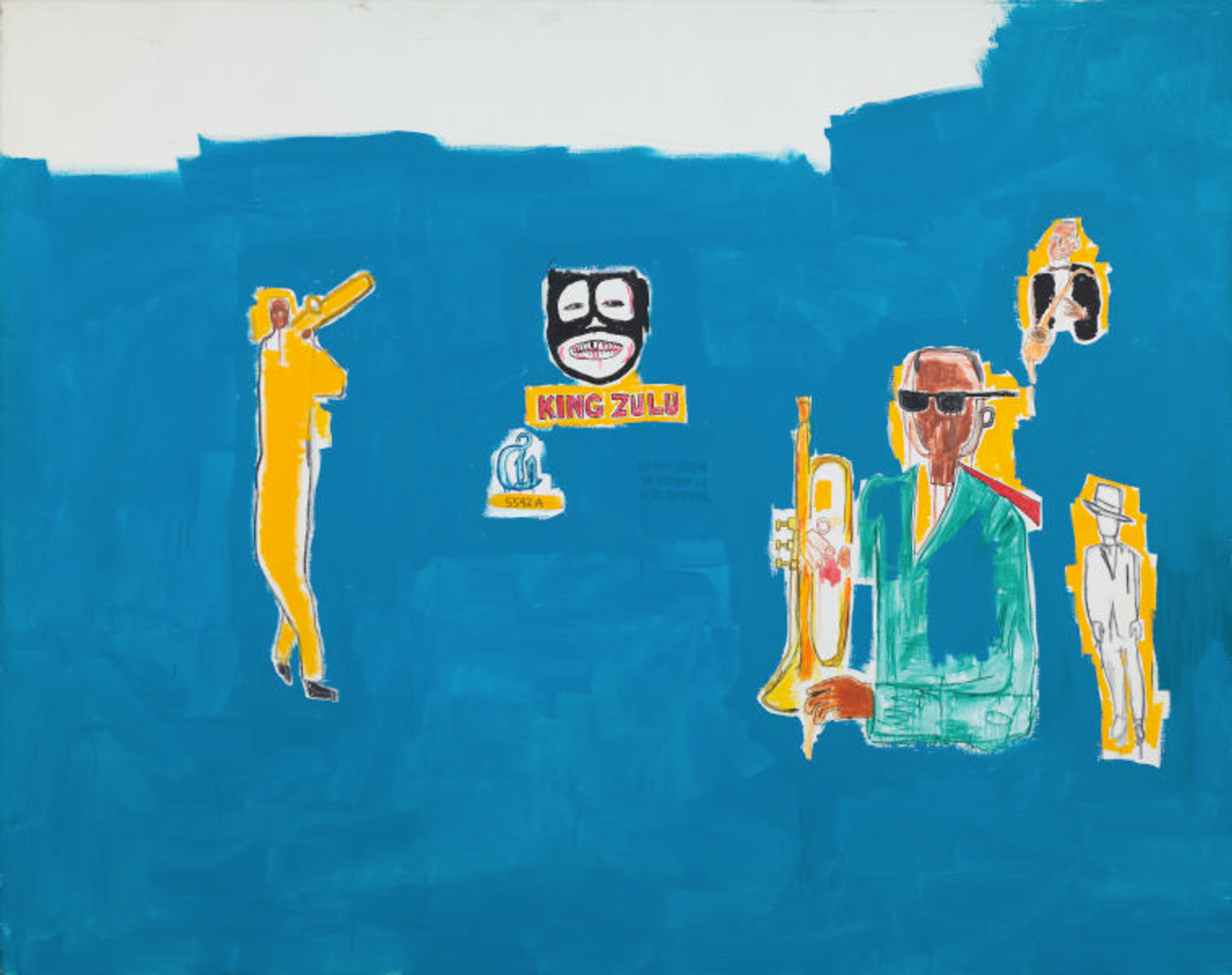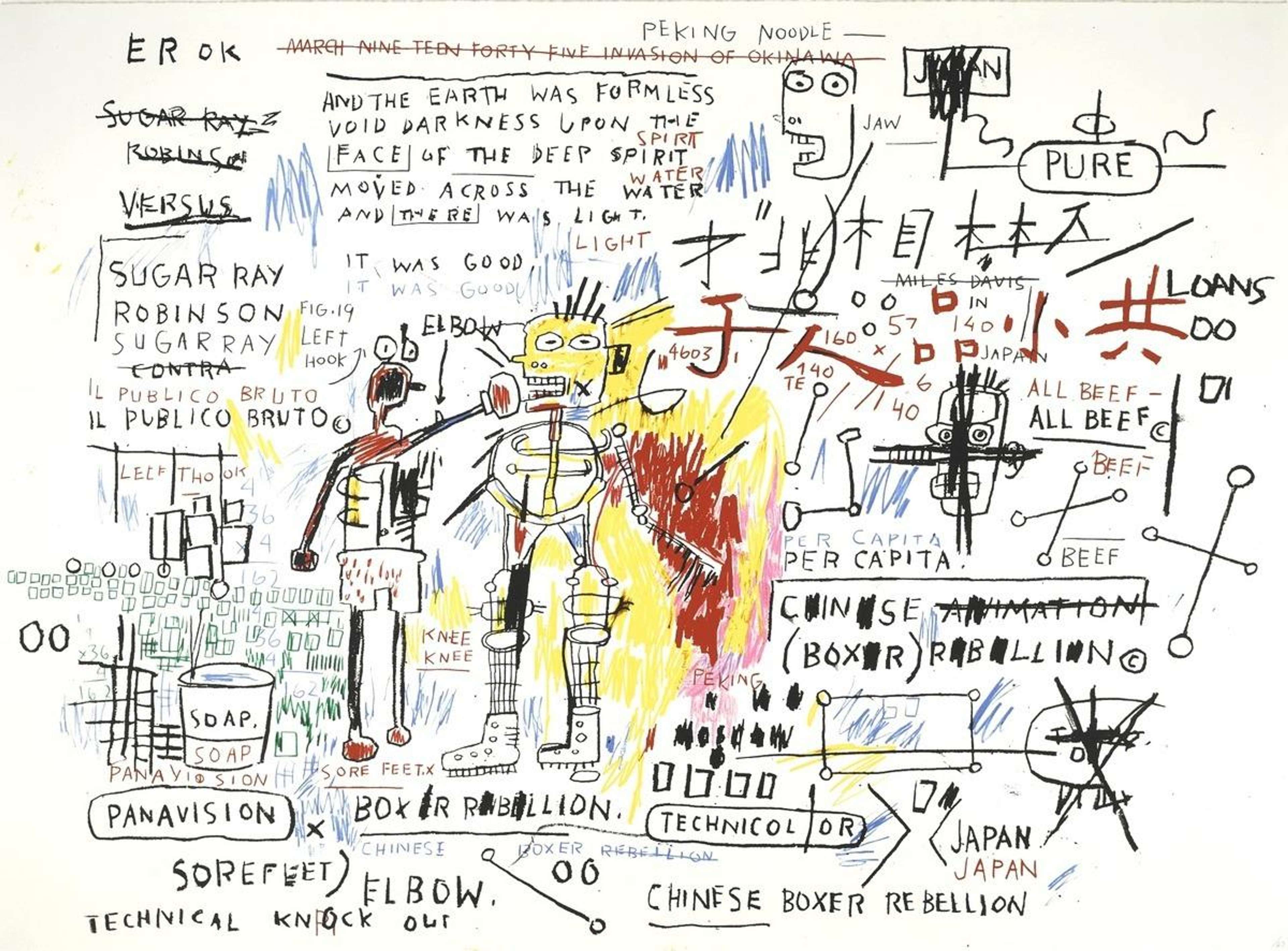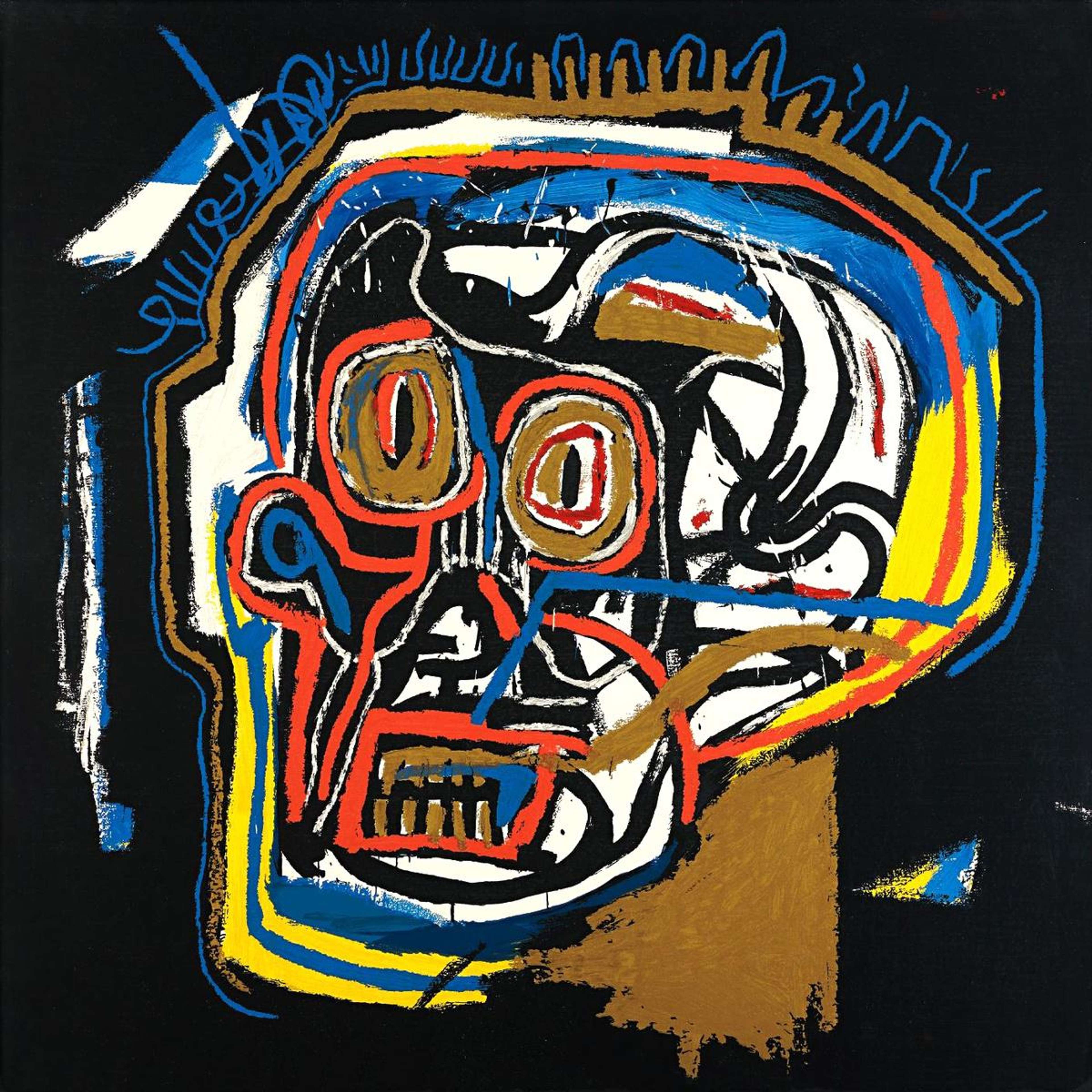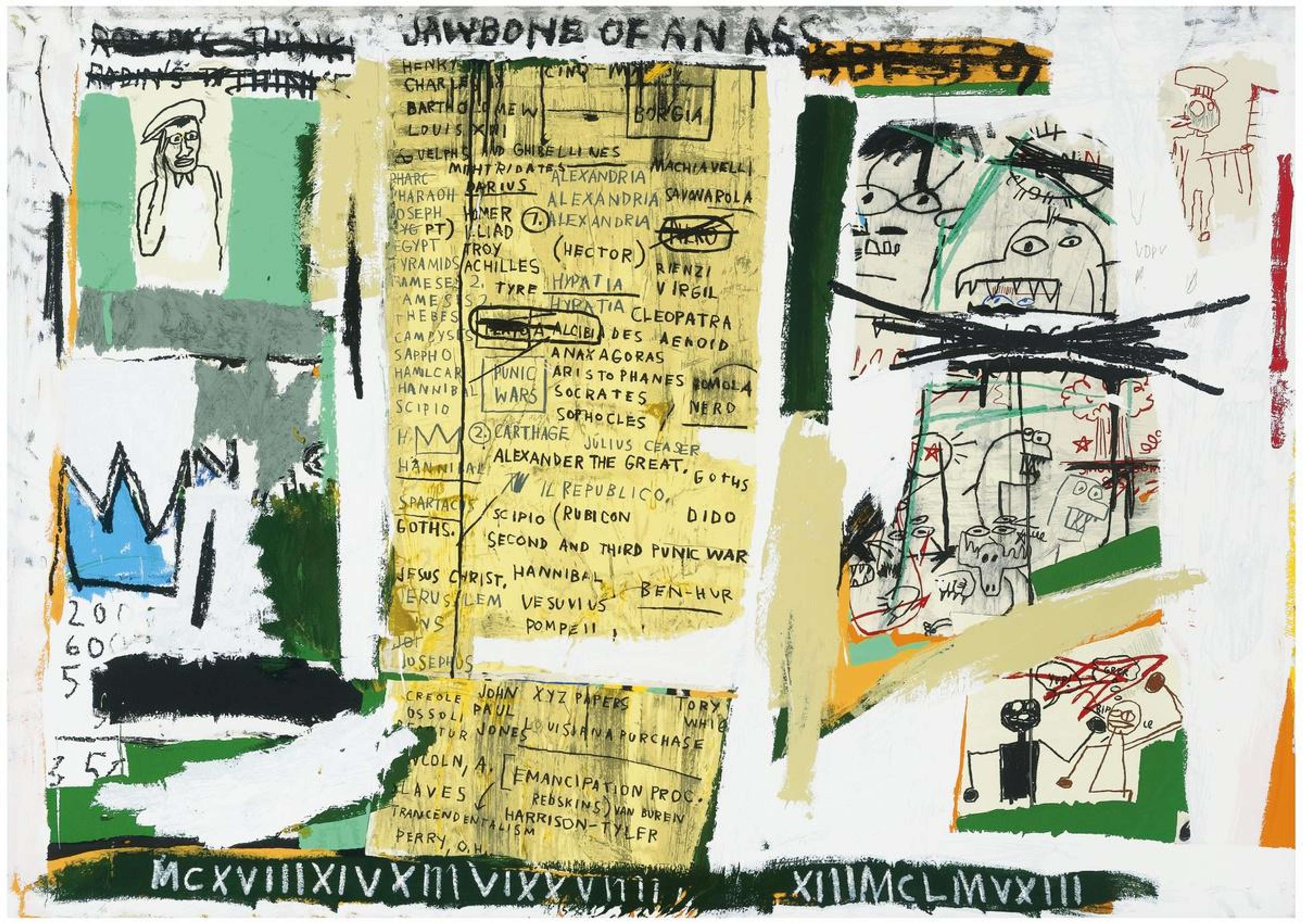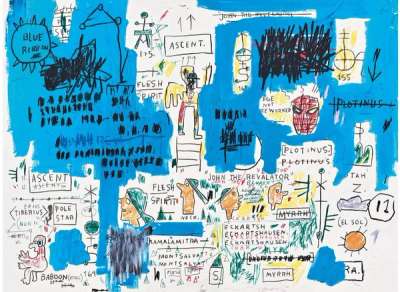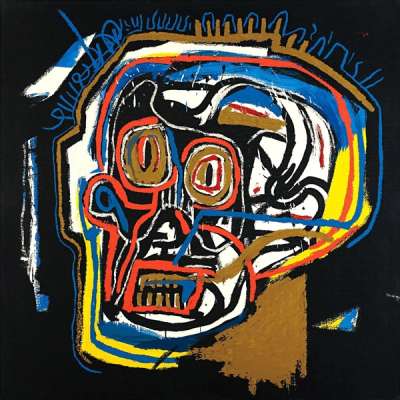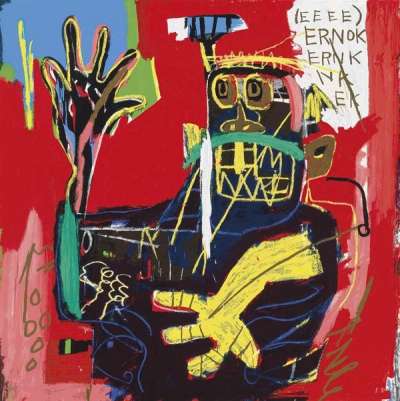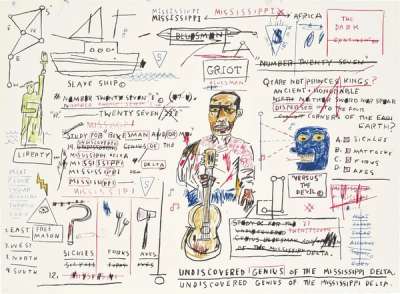 Jawbone Of An Ass © Jean-Michel Basquiat 2004
Jawbone Of An Ass © Jean-Michel Basquiat 2004
Jess Bromovsky, Sales Director[email protected]
Interested in buying or selling
Jean-Michel Basquiat?

Jean-Michel Basquiat
56 works
Jean-Michel Basquiat emerged in the early 1980s as a defining figure in the Neo-Expressionist movement, renowned for his raw, powerful compositions that blended elements of graffiti, drawing, and painting. His visual language, marked by a vibrant palette, aggressive brushstrokes, and fragmented anatomy, also deeply integrated text, poetry, and narrative, making his work uniquely expressive and intellectually engaging. Basquiat's texts were integral components that offered insight into his thoughts on identity, society, and culture. This fusion of visual and verbal elements underscored the depth of Basquiat's art, making it a commentary on the human experience.
Deciphering Basquiat's Symbolic Language
Basquiat's canvases are rich with symbols and motifs that serve as vital keys to deciphering the artist's intricate commentary on power, legacy, and identity. Among the most recurrent symbols in his oeuvre is the crown, a motif that transcends simple adornment to signify the sovereignty and excellence of its bearers. Frequently placed above the heads of figures that Basquiat deemed heroes or influencers within the African American community, the crown elevates individuals to a regal status, challenging historical narratives that have marginalised their contributions.
Warrior figures populate Basquiat's works as embodiments of resilience and defiance. These characters, often depicted amidst chaos and conflict, symbolise the artist's reflections on the struggles against systemic oppression faced by Black individuals. The warriors in Basquiat's art are not just fighters; they are protectors of their heritage and assertive claimants of their place within a societal structure that seeks to diminish their power.
Basquiat's use of code-like annotations adds another layer of complexity to his work. These cryptic messages invite viewers to engage in a more profound exploration of the themes presented, offering insights into Basquiat's thoughts on societal hierarchies, historical injustices, and the personal experiences shaping his identity. They function both as narrative devices and as visual elements that disrupt conventional readings of the artwork, compelling the audience to consider the intersections of text and image in understanding Basquiat's world. Through these symbols, Basquiat articulates a nuanced discourse on power dynamics, celebrating the resilience and ingenuity of those who have been historically disenfranchised.
Basquiat’s Literary Influences and Inspirations
Basquiat's art was deeply infused with the literary influences and inspirations he absorbed throughout his life. His eclectic reading habits spanned a wide range of poets, writers, and texts, from French symbolist literature to works by William S. Burroughs, and Langston Hughes. These literary sources not only provided thematic material for his art but also shaped his approach to integrating text into his visual compositions.
Basquiat's cultural background of Puerto Rican and Haitian heritage, further informed his use of text, imbuing his work with a diverse linguistic and symbolic vocabulary. References to African American history and Caribbean folklore frequently appeared alongside quotations and textual fragments, revealing the depth of his engagement with his cultural identity. This melding of literary, historical, and personal influences created a complex narrative layer within his artwork, where text served as a conduit for exploring broader cultural and existential questions. Through this synthesis of literary and cultural inputs, Basquiat constructed a unique artistic language that defied conventional categorisation, marking him as a pioneering figure in the dialogue between word and image in contemporary art.
Basquiat’s Fusion of Word and Image
Basquiat masterfully fused word and image to create a dynamic dialogue within his artworks, challenging traditional boundaries between visual and literary expression. His canvases are arenas where text and imagery coalesce, each element enhancing and informing the other. Basquiat's integration of text, ranging from poetic fragments to powerful, often politically charged phrases, served not only as a narrative thread but also as a visual component that added depth and complexity to his compositions.
The interplay between written word and imagery in Basquiat's art is marked by a symbiotic relationship where text acts as both commentary and an integral part of the visual aesthetic. This amalgamation of text and image invites viewers into a layered exploration of Basquiat's themes, including race, power, and social injustice, allowing for a multifaceted interpretation of his work. Through this innovative fusion, Basquiat not only expanded the possibilities of visual art but also established a unique language that continues to resonate with and inspire contemporary audiences.
The Daros Suite
Basquiat's Daros Suite emerges as a compelling showcase of Jean-Michel Basquiat's exploration into themes of racial injustice, historical depth, and socioeconomic divides. Through this series, Basquiat's iconic symbols merge with enigmatic texts, creating a complex narrative. This synthesis of imagery and words challenges viewers, urging deeper contemplation of societal issues. Each piece serves as a critical commentary, cementing the Daros Suite as a pivotal exploration of Basquiat's thematic concerns and symbolic mastery.
In Ascent, Basquiat employs textual references to historical and mystical figures such as Eckartshausen and Plotinus, alongside Christian mysticism and symbols of ancient Egyptian deities. This screenprint becomes a canvas where Basquiat's textual annotations act as guideposts, leading viewers through a labyrinth of spiritual and philosophical exploration. The mention of Plotinus, a philosopher foundational to Neoplatonism and influential in shaping the contours of major world religions, alongside the depiction of symbols associated with the sun and Christian mysticism, underscores Basquiat's quest for universal truths and enlightenment.
Conversely, Boxer Rebellion showcases Basquiat's adept use of text to create a double entendre that bridges historical and contemporary narratives of rebellion. The title itself, while directly referencing the historical Chinese uprising against colonial and Christian missionary influence, also subtly honours African American boxers who, in Basquiat’s view, battled against societal injustices and racial discrimination. This piece exemplifies how Basquiat's textual elements can serve multiple interpretive functions, offering commentary on both historical events and the ongoing struggle for racial equality and justice. Through the juxtaposition of these narratives, Basquiat underscores the enduring spirit of resistance and the complex interplay between individual identity and collective historical experience.
Themes and Narratives in Basquiat's Texts
Central to Basquiat's work is the theme of dichotomy—wealth versus poverty, integration versus segregation, and inner versus outer experience. Through his textual content, Basquiat navigates these contrasts, often juxtaposing symbols of affluence with language that speaks to marginalisation and disenfranchisement.
In Obnoxious Liberals, Basquiat used phrases such as “Gold,” “asbestos,” and “not for sale” to discuss the commodification of art and artists through the depiction of a black figure in handcuffs. This artwork serves as a broader critique of the art market, highlighting its deficiencies and the problematic nature of treating art merely as a commodity. Through his strategic incorporation of text, Basquiat not only critiques these practices but also emphasises the intrinsic value of art for its capacity to provoke thought and convey narratives.
Basquiat also explored themes of heritage and identity, using text to assert his cultural narrative within the broader American context. In the piece "Basquiat's Undiscovered Genius" from the Daros Suite series, Basquiat delves into the art world's prejudices through the lens of a nameless Black musician's portrayal. At the heart of the artwork, the phrase 'GRIOT BLUESMAN' bridges two worlds: the 'griot', a revered West African storyteller, and the American 'bluesman', creating a powerful link that highlights the African roots of blues music and celebrates the depth of Black musical traditions. This work subtly weaves in references to the Mississippi Delta, positioning the musician in opposition to the text '“VERSUS” THE DEVIL ⓒ', a poignant commentary on the unjust characterization of blues as 'the Devil’s music'. Through this juxtaposition, Basquiat elevates the genre beyond its stigmatised labels, emphasising its rich historical and cultural essence.
Basquiat's Anatomy series stands as a testament to his unique ability to blend literal text with visual art, particularly in depicting anatomical structures. Drawing from his childhood fascination with Gray's Anatomy, Basquiat infused these works with detailed, text-based labels that complement and elucidate the depicted bodily forms. This literal use of text serves not only as an educational tool but also deepens the viewer's engagement with the artwork, inviting a more informed exploration of the human body. Through this series, Basquiat demonstrates how text can enhance the visual experience, grounding abstract concepts in reality and providing a bridge between the viewer’s understanding and the artist’s vision.
The Socio-Political Context of Basquiat's Textual Artwork
The 1980s saw the escalation of the civil rights movement's aftermath, with communities across the United States grappling with the ongoing struggle for racial equality and justice. Basquiat, as a young African American artist in New York City, was acutely aware of these issues, which permeated his work. His art became a canvas for exploring and contesting the racial prejudices and systemic inequalities that persisted in American society. Through textual elements, Basquiat often highlighted the plights and resilience of Black individuals, weaving narratives that spoke to the collective experience of marginalisation and the fight for dignity and rights.
Economic disparities of the era, exacerbated by policies that favoured the wealthy, found their way into Basquiat's work through texts that critiqued materialism and the commodification of culture. His art interrogated the intersections of wealth, power, and exploitation, offering a critique that was both personal and universal. The textual content in his pieces frequently juxtaposed symbols of affluence with those of poverty, underscoring the stark inequalities that defined the decade.
Moreover, the emergence of hip-hop culture as a powerful form of expression among urban youth deeply resonated with Basquiat. His work captured the energy, defiance, and creativity of hip-hop, employing text to echo its themes of resistance, identity, and social commentary. Basquiat's art mirrored the linguistic inventiveness of rap lyrics, incorporating vernacular, slang, and references that bridged visual art with the sonic landscapes of the streets.
In this socio-political context, Basquiat's textual artwork served not only as a reflection of the times but also as a response to them. His integration of text, image, and symbolism provided a multifaceted commentary on the complexities of race, class, and culture in the 1980s. Through his art, Basquiat engaged in a dialogue with contemporary social issues, positioning himself as both an observer and a participant in the broader cultural movements of his time.
Basquiat's Legacy in Modern Art and Culture
Basquiat's legacy continues to pulsate through the veins of contemporary art, inspiring artists across the globe. His raw, emotive expressions and the bold integration of text and symbolism have carved a path for exploring complex narratives within the canvas, encouraging a dialogue between art and observer that transcends conventional boundaries.
Basquiat's influence is palpable in the work of a diverse array of artists who, drawn to his innovative use of language and symbols, adopt similar methods to tackle issues of identity, power, and social injustice. His ability to blend poetry with painting, infusing his pieces with layered meanings, remains a beacon for those navigating the intersection of art and activism. In cultural contexts, Basquiat's legacy is equally profound, his art becoming a symbol of resistance and a call to action, urging new generations to question and dismantle the systemic barriers that pervade society.







